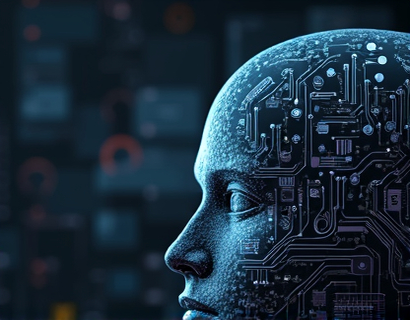UX Design Trends 2025: Mastering Digital Transformation with Expert Strategies for Enhanced User Experience
In the rapidly evolving landscape of digital products and services, UX design plays a pivotal role in driving success and user satisfaction. As we step into 2025, the field of UX design continues to evolve, influenced by technological advancements, changing user behaviors, and emerging design trends. This comprehensive guide aims to equip UX designers and enthusiasts with the latest insights, expert strategies, and practical tips to master digital transformation and enhance user experience.
Understanding the Current UX Design Landscape
The UX design landscape in 2025 is characterized by a focus on inclusivity, personalization, and seamless integration of technology into daily life. With the increasing use of AI and machine learning, designers are leveraging these technologies to create more intuitive and adaptive user experiences. Accessibility remains a critical aspect, with a stronger emphasis on designing for diverse user needs, including those with disabilities.
Another significant trend is the rise of voice user interfaces (VUIs) and conversational design. As smart speakers and voice assistants become more prevalent, UX designers must consider how to create effective and natural interactions through voice commands. This shift requires a deep understanding of conversational flow, context awareness, and the nuances of voice-based interactions.
Inclusivity and Diversity in UX Design
Inclusivity in UX design is no longer a niche concern but a fundamental principle. Designers are tasked with creating products that are accessible and usable for a wide range of users, regardless of their abilities, cultures, or backgrounds. This involves conducting thorough user research to understand the diverse needs and preferences of the target audience.
One effective strategy is to adopt a user-centered design approach, which places the user at the center of the design process. This includes creating user personas that represent different demographics and conducting usability tests with a diverse group of participants. By doing so, designers can identify and address potential barriers, ensuring that the final product is inclusive and equitable.
Personalization and Adaptive UX
Personalization has become a key differentiator in the digital space. Users expect experiences that are tailored to their preferences and behaviors. To achieve this, UX designers are leveraging data and analytics to create adaptive interfaces that respond to user actions and context.
One approach is to implement dynamic content and layout adjustments based on user behavior. For example, a news app might prioritize articles based on a user's reading history and interests. Additionally, machine learning algorithms can be used to predict user needs and proactively offer relevant content or features.
Another aspect of personalization is the use of customization options, allowing users to tailor the interface to their liking. This could include adjustable themes, font sizes, and layout configurations. By providing these options, designers can enhance user satisfaction and engagement.
Seamless Integration of AI and Machine Learning
The integration of AI and machine learning into UX design is transforming the way products interact with users. These technologies enable the creation of intelligent systems that can learn from user interactions, adapt over time, and provide personalized experiences.
One notable application is chatbots and virtual assistants, which use natural language processing (NLP) to understand and respond to user queries. To design effective conversational interfaces, UX designers must focus on crafting natural and intuitive dialog flows. This involves understanding the context of conversations, anticipating user needs, and providing relevant and helpful responses.
AI can also be used to enhance accessibility. For instance, machine learning algorithms can analyze user behavior to detect and accommodate different abilities, such as providing text-to-speech options for users with visual impairments or simplifying complex interfaces for those with cognitive disabilities.
Micro-Interactions and Feedback
Micro-interactions are small, focused interactions that provide immediate feedback to users, enhancing the overall user experience. In 2025, designers are paying closer attention to these subtle yet impactful elements, as they contribute to a sense of responsiveness and engagement.
Examples of micro-interactions include loading animations, form validation messages, and notification badges. These elements should be designed to be visually appealing, informative, and non-intrusive. By carefully crafting micro-interactions, designers can guide users through the interface, confirm actions, and provide reassurance, all of which contribute to a more satisfying user experience.
Dark Mode and Visual Design Trends
The popularity of dark mode continues to grow, driven by user preferences for reduced eye strain and a more modern aesthetic. UX designers are incorporating dark mode as a standard feature in their designs, ensuring that it is not just a cosmetic change but a thoughtful consideration of user comfort and accessibility.
Beyond dark mode, visual design trends in 2025 emphasize simplicity, clarity, and minimalism. Clean interfaces with ample white space, consistent typography, and a limited color palette help to reduce cognitive load and improve usability. Designers are also exploring the use of gradients, subtle animations, and dynamic typography to add depth and visual interest without overwhelming the user.
Mobile-First and Responsive Design
With the majority of users accessing digital products through mobile devices, a mobile-first approach remains crucial. UX designers must prioritize mobile usability, ensuring that products are optimized for smaller screens and touch interactions. This involves designing for touch targets, optimizing content layout, and testing on a variety of devices and screen sizes.
Responsive design continues to be a cornerstone of UX design, allowing products to adapt seamlessly to different devices and orientations. Designers should employ flexible grids, fluid images, and media queries to create a consistent and cohesive user experience across all platforms.
Performance and Load Times
Performance is a critical factor in user satisfaction and retention. In 2025, UX designers are focusing on optimizing load times and ensuring that products are fast and responsive. This involves optimizing images, minifying code, leveraging browser caching, and using content delivery networks (CDNs).
Another aspect of performance optimization is lazy loading, which delays the loading of non-essential elements until they are needed. This can significantly reduce initial load times and improve the overall user experience. Designers should also consider the impact of third-party scripts and plugins, ensuring that they do not hinder performance.
Voice User Interfaces and Conversational Design
The rise of voice assistants and smart speakers has sparked a new wave of interest in voice user interfaces (VUIs). Designing for voice requires a different approach compared to traditional screen-based interactions. UX designers must focus on creating natural, conversational flows that mimic human dialogue.
Key considerations include simplifying language, avoiding jargon, and providing clear and concise responses. Designers should also account for context, allowing the system to remember previous interactions and maintain a coherent conversation. Additionally, error handling and fallback options are essential to ensure a smooth user experience even when misunderstandings occur.
Data Privacy and Trust
As concerns about data privacy and security continue to grow, UX designers must prioritize transparency and trust in their designs. This involves clearly communicating how user data is collected, used, and protected. Designers should implement intuitive privacy settings and provide users with control over their data.
Building trust also involves being upfront about data practices and avoiding hidden or overly complex terms of service. By fostering a culture of transparency and accountability, designers can enhance user confidence and loyalty.
Future-Proofing UX Design
To stay ahead in the ever-changing digital landscape, UX designers must embrace a forward-thinking mindset. This involves staying informed about emerging technologies, trends, and user behaviors. Participating in industry conferences, following design research, and experimenting with new tools and techniques are all essential practices.
Moreover, designers should focus on creating flexible and scalable designs that can adapt to future changes. This includes designing for new devices, platforms, and interaction paradigms. By future-proofing their designs, UX professionals can ensure that their products remain relevant and valuable over time.
Conclusion
In conclusion, the UX design trends of 2025 are shaped by a commitment to inclusivity, personalization, and the seamless integration of technology. By embracing these trends and implementing expert strategies, UX designers can drive digital transformation and deliver exceptional user experiences. Whether it's through inclusive design practices, adaptive interfaces, or performance optimization, the goal remains the same: to create products that resonate with users and meet their evolving needs.










































